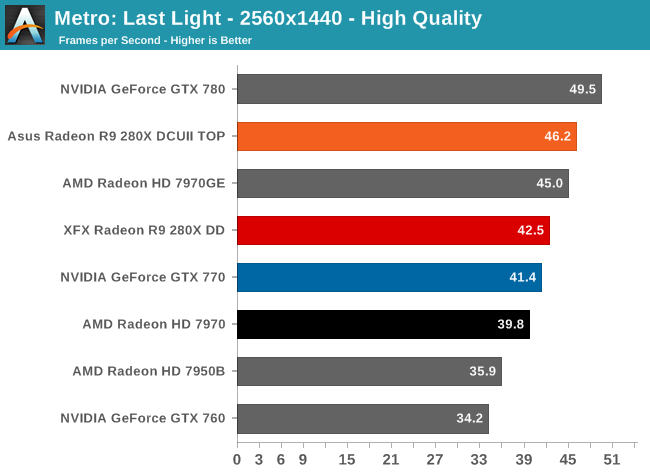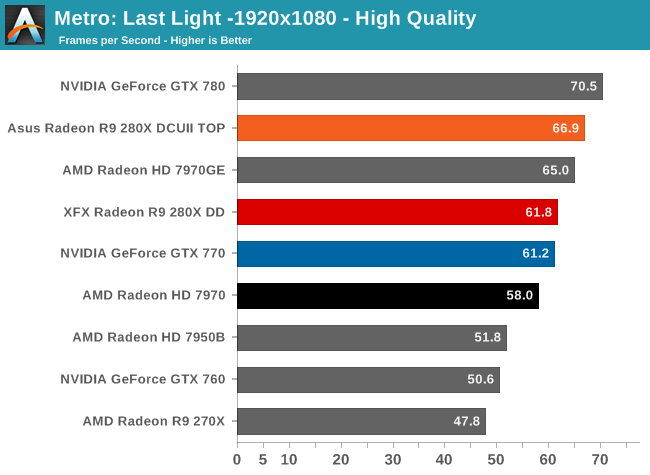The Radeon R9 280X Review: Feat. Asus & XFX - Meet The Radeon 200 Series
by Ryan Smith on October 8, 2013 12:01 AM ESTMetro: Last Light
Kicking off our look at performance is 4A Games’ latest entry in their Metro series of subterranean shooters, Metro: Last Light. The original Metro: 2033 was a graphically punishing game for its time and Metro: Last Light is in its own right too. On the other hand it scales well with resolution and quality settings, so it’s still playable on lower end hardware.



The first benchmark in our revised benchmark suite finds our 280X cards doing well for themselves, and surprisingly not all that far off from the final averages. Setting the baseline here, as we expected the Tahiti based 280X performs in between the original 7970 and 7970 GHz Edition, thanks to the 280X’s use of PowerTune Boost but at lower clockspeeds than the 7970GE. Consequently this isn’t performance we haven’t seen before, but it’s very much worth keeping in mind that the 7970GE was a $400 card while the 280X is a $300 card, so approaching the 7970GE for $100 less is something of a significant price cut for the performance.
As for the immediate competitive comparison, we’ll be paying particular attention to 2560x1440, which should be the sweet spot resolution for this card. At 2560 we can see that the reference clocked 280X doesn’t just hang with the $400 GTX 770 but actually manages to edge it out by just over a frame per second. As a preface we’re going to see these two cards go back and forth throughout our benchmarks, but to be able to directly compete with NVIDIA’s fastest GK104 card for $100 less is a significant accomplishment for AMD.
Finally, let’s quickly talk about the Asus 280X versus the XFX 280X. Asus winning comes as no great shock due to their factory overclock, but now we finally get to see the magnitude of the performance gains from that overclock. At 2560 we’re looking at just shy of a 9% performance gain, which is in excess of both the boost clock overclock and the memory overclock. The specific performance gains will of course depend in the game in question, but this means that the performance gains in at least one instance are being impacted by the base clock overclock, the larger of Asus’s factory overclocks.










151 Comments
View All Comments
Sabresiberian - Wednesday, October 9, 2013 - link
I don't think any current game dev can complain about the top API suites today when they don't even take advantage of the hardware available.Kudos to those beginning to take advantage of multiple cores in CPUs, but what you are doing clearly isn't enough. It is ridiculous that a 6-core hyperthreaded CPU doesn't provide a significant performance boost in any of today's games over a 4-core CPU without hyperthreading, and we've had them for 5 years now, so the hardware has been around longer than the development cycle of most games and should be taken advantage of by now. This is not the fault of Direct3D or OpenGL.
I'm excited about the possibilities of Mantle, but skeptical of the results. We'll see.
AnnihilatorX - Thursday, October 10, 2013 - link
On the page about TrueAudioshould it read:
Tensilica’s audio DSPs are task-specific programmable hardware, somewhere between fixed [s]function[s] and fully programmable in function,
?
Hixbot - Friday, October 11, 2013 - link
Well another gen of graphics cards and no serious change in performance per dollar. The past 2 years of PC hardware development have been BORING. Why do the big players refuse to compete seriously?fantasysportsguy - Saturday, October 12, 2013 - link
So if you have an HD 7850, what is the upgrade path?SirKronan - Sunday, October 13, 2013 - link
"Of course the fact that AMD also needs to get rid of the 7000 series at the same time isn’t going to do them any favors. There’s no getting around the fact that similar 7000 series products are going to be equal to or cheaper than 200 series products, at least for the immediate launch. "This prediction turned out to be WRONG. It is what I was expecting as well, but the opposite happened. Every 7970 on just about every store I shop at seems to have JUMPED by about $80.
What the heck??
Compuservant - Monday, October 14, 2013 - link
You do realize there is another Asus R9 280 GPU. The Asus R9 280X Matrix Platinum is their top model in this specific range and ships with a core overclock at 1,100mhz. The GDDR5 memory has also been overclocked to 1,600mhz (6.4Gbps effective).Aside from the massive overclock, Matrix R9 280X graphics cards have exclusive ROG VGA Hotwire technology built in for even more overclocking headroom. By wiring the Matrix R9 280X’s VGA Hotwire terminals to header connections on the motherboard, users are able to overvolt right away.
In conjunction with the TweakIt utility and the plus and minus buttons fitted to some ASUS ROG motherboards, VGA Hotwire puts overvolting adjustments at users’ fingertips – so they can gradually and safely increase power for higher speeds and smoother gaming. With Matrix R9 280X cards, TweakIt offers a wider voltage-modulation range than ever before and it’s also possible to immediately activate the dual 100mm fans — enabling maximum airflow and instant cooling at the touch of a button.
Most of above was cut and paste (sorry), but do you know of a supported motherboard for the i7 4770k CPU?
I think I read that the new cards can do crossfire without a bridge/connector. Imagine the performance for $650 or so, for 2 280x Matrix Platinums!
Death666Angel - Tuesday, October 15, 2013 - link
I know the article is older, but I just got to it.In the overclocking section, you write:
"The Asus card meanwhile was good for 40MHz more, for a 4% base/4% boost overclock, while its memory could do an additional 800MHz (13%)."
But it base clock is factory overclocked at 6.4GHz and it achieves a 6.8GHz clock in your test, so it is "just" a 400 MHz boost.
Dragonheart.BY - Thursday, November 14, 2013 - link
Is there any info about 280 non-x? Will it be released at all?inFormal - Wednesday, December 18, 2013 - link
I m trying to find (& order) an Asus R9 280x DCII 3GB (Tahiti XTL) but everywhere i looked they're "OUT OF STOCK" ... what the fudge ? Don t they know that i am prone to do useless it shopping during December ?dsmogor - Friday, January 24, 2014 - link
Can SteamOS access that as well (by having Mantle somewhat integrated with OGL) we would have a winninng arch/software combination.